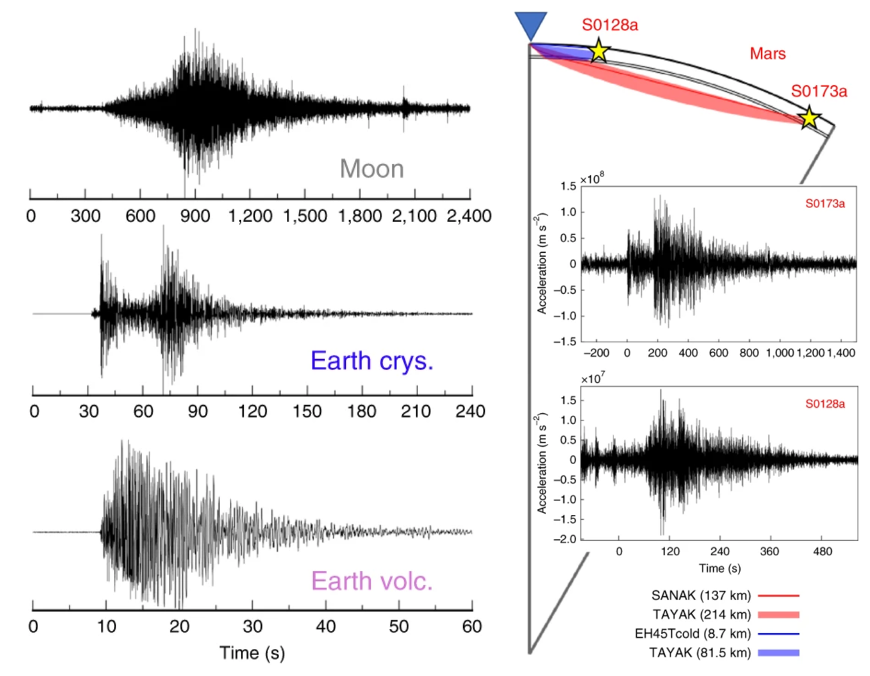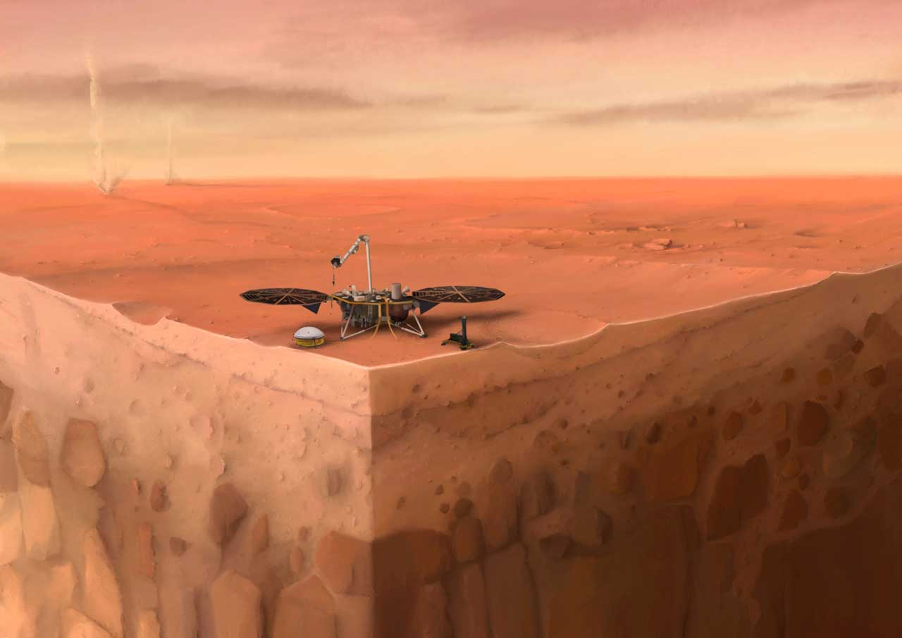Featured image: An artist’s concept of NASA’s InSight lander on Mars with a cutaway of the surface below. Credit: IPGP/Nicolas Sarter.
Paper: Constraints on the shallow elastic and anelastic structure of Mars from InSight seismic data
Authors: Philippe Lognonné et al.,
Scientists are able to ‘see’ the internal structure of the Earth based on seismic waves recorded during Earthquakes. Earthquakes send seismic waves out in all directions with two main types: (1) surface waves are the major culprits of Earthquake damage as they remain on the surface; (2) faster body waves can travel down within Earth’s interior. The body waves are the fastest seismic waves, consisting of the first (primary; P-wave) and second (secondary, S-wave) waves to arrive at a location away from the epicentre of an Earthquake.
Seismometers pick up seismic waves and scientists can use the resulting data to discover the depth of internal layers and to hypothesize what rock type could make up those layers. It’s so useful that they decided to send a seismometer to Mars.
NASA’s InSight mission – Interior Exploration using Seismic Investigations, Geodesy and Heat Transport – has been stationed on Mars since 26th November 2018 to explore the interior of Mars. This paper focussed on the seismic data generated from Marsquakes.
The authors of this paper reported 3 major Marsquakes that have allowed scientists a glimpse beneath the Martian surface. Marsquakes with smaller magnitudes will not have seismic waves that travel far down into the subsurface. The authors analysed 2 of the biggest Marsquakes with surprisingly similar seismograms.

Comparison seismograms. The left-hand graphs compare seismograms from the moon and two differing Earth environments, a crystalline Massif and a volcanic region. The graphs on the right display the two seismograms from the Marsquakes on the background of a cutaway of Mars’ interior showing seismic waves travelling through Mars.
Seismologists are trained to decipher these seismograms to search for the clues about the planet’s interior, especially the delay between the P-waves and the S-waves.
The fastest seismic wave is the P-wave. When P-waves travel down within a planet and encounter a discontinuity or physical change to the rock – for example the interface between the crust and mantle – it can be reflected back toward its source, change direction, or even transform into a slower S-wave. Often a combination of these occurs, scattering waves throughout the planet’s interior.
The fast P-waves and slower S-waves arrive at the ground surface at different times. The arrival time delay is dependent on the rock composition, the temperature and the depth where these physical properties change.
In this paper, the seismologists discovered that the two Marsquakes had nearly identical arrival time delays. However, the events occurred on different sols (Martian days), ~450 km apart and in opposite directions with respect to the InSight lander so why are their resulting seismograms so similar?
Complexities in crustal rock geology can cause seismic waves to bounce around at the surface causing lots of seismogram ‘noise’. The authors hypothesized that the seismic waves probably travelled through the Martian mantle on route to InSight and therefore had a distinct lack of noise in the seismograms. This allowed for the identification of P-waves transforming into S-waves at rock layers in the crustal region beneath InSight. The data is giving scientists an insight into composition of the Martian crust.
The authors have concluded that the upper 8 to 11 km of the Martian crust beneath InSight is likely highly altered or fractured. This may have to do with the complexities this region has undergone over time. InSight landed in a volcanic region of Mars named Elysium Planitia which is believed to be an area of basalt, a common volcanic rock.
The authors found similarities between Earthquakes and Moonquakes seismograms suggesting that the planetary bodies have similar subsurface features and materials. There is a strong scattering shown on seismograms in volcanic regions on Earth and the Moon due to volatiles within the crust. Volatile elements have low boiling points; these elements can cause explosive volcanic eruptions. The Martian seismograms also display some scattering; it is possible that this area of Mars contains volatile elements too.
The InSight mission has certainly lived up to its name already; and this merely scratches the surface of Mars. An even larger Marsquake would allow us to probe deeper into the planet, and just think what an entire network of seismometers on Mars could discover about the interior of this planet.
Marsquakes give scientists an InSight to Mars by Emma Harris is licensed under a Creative Commons Attribution-ShareAlike 4.0 International License.


Given the composition of the rock faces on Mars, would somebody attempting to climb a wall of Martian rock have a good grip? Or might they fall down into space brambles?